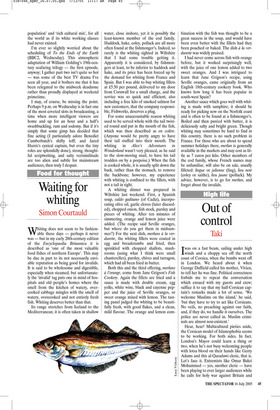Food for thought
Waiting for whiting
Simon Courtauld
Whiting does not seem to be fashionable these days — perhaps it never was — but in my early 20th-century edition of the Encyclopaedia Britannica it is described as ‘one of the most valuable food fishes of northern Europe’. This may be due in part to its not necessarily enviable reputation as being good for invalids. It is said to be wholesome and digestible, especially when steamed, but unfortunately the ‘invalid’ tag puts one in mind of hospitals and old people’s homes where the smell from the kitchen of watery, overcooked cabbage mingles with the smell of watery, overcooked and not entirely fresh fish. Whiting deserves better than that.
Its range stretches from Iceland to the Mediterranean; it is often taken in shallow water, close inshore, yet it is possibly the least-known member of the cod family. Haddock, hake, coley, pollack are all more often found at the fishmonger’s. Indeed, so rarely is the whiting sighted in Wiltshire that I had some trouble getting it. Apparently it is considered, by fishmongers at least, to be inferior to haddock and hake, and its price has been forced up by the demand for whiting from France and Spain. But I was able to buy whiting fillets at £5.50 per pound, delivered to my door from Cornwall for a small charge, and the service was so quick and efficient, also including a free kilo of smoked salmon for new customers, that the company responsible, Fishworks, deserves a plug.
For some unaccountable reason whiting used to be served whole with the tail twisted round and put in the mouth of the fish, which was then described as en colère. (Anyone would be pretty angry to have their tail stuffed into their mouth. The whiting in Alice’s Adventures in Wonderland wasn’t very pleased, as he said to the slow-moving snail, to have his tail trodden on by a porpoise.) When the fish is cooked whole, it is usually split down the back, rather than the stomach, to remove the backbone; however, my experience with whiting is confined to the fillets, with not a tail in sight.
A whiting dinner was prepared in Wiltshire last weekend. First, a Spanish soup, caldo gaditano (of Cadiz), incorporating olive oil, garlic cloves (later discarded), chopped onion, fish stock, parsley and pieces of whiting. After ten minutes of simmering, orange and lemon juice were added. (The recipe said Seville oranges, but where do you get them in midsummer?) For the next dish, merlans à la verdurette, the whiting fillets were coated in egg and breadcrumbs and fried, then sprinkled with chopped shallots, mushrooms (using what I think were small chanterelles), parsley, chives and tarragon, which had all been fried in butter.
Both this and the third offering, merlans à l’orange, come from Jane Grigson’s Fish Cookery. Again the fillets are fried and a sauce is made with double cream, egg yolks, white wine, black and cayenne pepper and the juice of Seville oranges, or sweet orange mixed with lemon. The tasting panel judged the whiting to be beautifully fresh, with good flakes, and a clean, mild flavour. The orange and lemon com bination with the fish was thought to be a great success in the soup, and would have been even better with the fillets had they been poached or baked. The dish à la verdurette was widely praised.
I had never come across fish with orange before, but it worked surprisingly well, with the juice of one lemon added to two sweet oranges. And I was intrigued to learn that Jane Grigson’s recipe, using Seville oranges, came originally from an English 18th-century cookery book. Who knows how long it has been popular in south-west Spain?
Another sauce which goes well with whiting is made with samphire; it should be ready for picking now on the Norfolk coast and is often to be found at a fishmonger’s. Boiled and then puréed with butter, it is deliciously salty and bright green. Though whiting may sometimes be hard to find in this country, there is no such problem in France. For those who are about to spend summer holidays there, merlan is generally available in the markets and may cost as little as 7 euros per kilo. Other members of the cod family, whose French names may be unfamiliar, will also be on sale, usually filleted: lingue or julienne (ling), lieu noir (coley or saithe), lieu jaune (pollack). My advice, however, is to go for merlan, and forget about the invalids.


























































 Previous page
Previous page